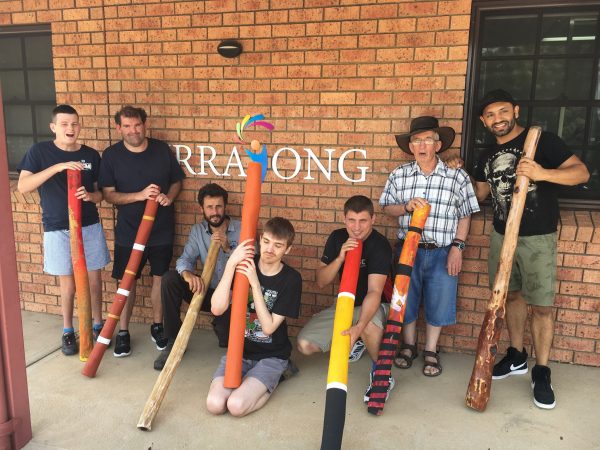
LAST week Allan McKenzie ran a hugely popular and successful two-day didgeridoo workshop at Currajong Disability Services in Parkes.
The workshop, in line with indigenous tradition and custom, was open to men only as the didgeridoo is seen a phallic extension of man. Men, as per indigenous culture are also the only one’s allowed to play the instrument.
“The participants had an incredible time,” said Allan McKenzie, workshop co-ordinator.
“Everyone embraced the course and we were extremely impressed with the visions of many.
“We can’t wait to come back again and maybe take them out to Country and do some more work with this amazing group,” he said.
HISTORY OF THE DIDGERIDOO
According to Wikipedia, the didgeridoo (a wind instrument developed by Indigenous Australians), was potentially first created 1500 years ago in northern Australia. It is sometimes described as a natural wooden trumpet or “drone” pipe. Musicologists classify it as a brassaerophone.
There are no reliable sources stating the didgeridoo’s exact age. Archaeological studies of rock art in Northern Australia suggest that the people of the Kakadu region of the Northern Territory have been using the didgeridoo for less than 1,000 years, based on the dating of paintings on cave walls and shelters from this period.[2]A clear rock painting in Ginga Wardelirrhmeng, on the northern edge of the Arnhem Land plateau, from the freshwater period[3] (that had begun 1500 years ago)[4] shows a didgeridoo player and two songmen participating in an Ubarr Ceremony.[5]
A modern didgeridoo is usually cylindrical or conical, and can measure anywhere from 1 to 3 m (3 to 10 ft) long. Most are around 1.2 m (4 ft) long. Generally, the longer the instrument, the lower its pitch or key. However, flared instruments play a higher pitch than unflared instruments of the same length.
Traditionally and originally, the didgeridoo was primarily played as an accompaniment to ceremonial dancing and singing. However, it was also common for didgeridoos to be played for solo or recreational purposes outside of ceremonial gatherings. For surviving Aboriginal groups of northern Australia, the didgeridoo is still an integral part of ceremonial life, as it accompanies singers and dancers in cultural ceremonies that continue. Today, the majority of didgeridoo playing is for recreational purposes in both Indigenous Australian communities and elsewhere around the world.
Pair sticks, sometimes called clapsticks or bilma, establish the beat for the songs during ceremonies. The rhythm of the didgeridoo and the beat of the clapsticks are precise, and these patterns have been handed down for many generations. In the Wangga genre, the song-man starts with vocals and then introduces blima to the accompaniment of didgeridoo.[19]
Traditionally, only men play the didgeridoo and sing during ceremonial occasions, although both men and women may dance. Female didgeridoo players do exist, but their playing takes place in an informal context and is not specifically encouraged by Aboriginal elders.
